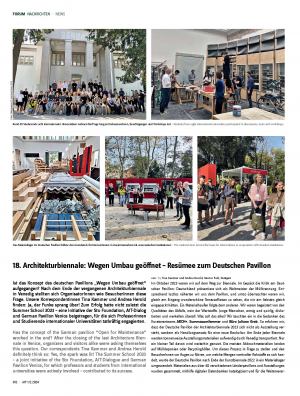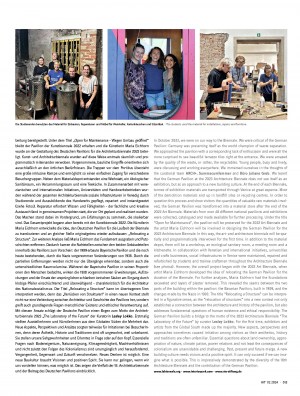18. Biennale of Architecture
Open for Maintenance
Summary of the German Pavilion
AIT
January/February 2024
page 12 + 13
In October 2023, we were on our way to the Biennale. We were critical of the German Pavilion: Germany was presenting itself as the world champion of waste separation.
We approached the pavilion with a corresponding lack of enthusiasm and were all the more surprised to see beautiful terrazzo tiles right at the entrance. We were amazed by the quality of the waste, or rather, the recyclables. Young people, busy and lively, were discussing and working everywhere. We immersed ourselves in the thoughts of the curatorial team ARCH+, Summacumfemmer and Büro Juliane Greb.
We learnt that the German Pavilion at the 2023 Architecture Biennale does not see itself as an exhibition, but as an approach to a new building culture.
At the end of each Biennale, tonnes of exhibition materials are transported through Venice at great expense. Most of the demolition materials end up in landfill sites or recycling centres. In order to question this process and show visitors the quantities of valuable raw materials involved, the German Pavilion was transformed into a material store after the end of the 2022 Art Biennale. Materials from over 40 different national pavilions and exhibitions were collected, catalogued and made available for further processing.
Under the title “Open for Maintenance”, the pavilion will be preserved for the 2022 Art Biennale and the artist Maria Eichhorn will be involved in designing the German Pavilion for the 2023 Architecture Biennale. In this way, the art- and architecture biennials will be spatially and programmatically interwoven for the first time.
In addition to the material depot, there will be a workshop, an ecological sanitary room, a meeting room and a kitchenette.
In collaboration with Venetian and international initiatives, universities and crafts businesses, social infrastructures in Venice were maintained, repaired and refurbished by students and trainee craftsmen throughout the Architecture Biennale.
However, the overall project began with the 2022 Art Biennale, when artist Maria Eichhorn developed the idea of relocating the German Pavilion for the duration of the Biennale. For further analyses, Maria Eichhorn had the foundations excavated and layers of plaster removed. This revealed the seams between the two parts of the building within the pavilion: the Bavarian Pavilion, built in 1909, and the changes made by the Nazis in 1938.
The title “Relocating a Structure” can be interpreted in a figurative sense, as the “relocation of structures” into a new context not only establishes a connection between the architecture and history of the pavilion, but also addresses fundamental questions of human existence and ethical responsibility.
The German Pavilion builds a bridge to the motto of the 2023 Architecture Biennale “The Laboratory of the Future” by curator Lesley Lokko. For the first time, exhibitors and artists from the Global South made up the majority. New aspects, perspectives and approaches sometimes caused irritation among visitors as their aesthetics, history and traditions are often unfamiliar. Essential questions about land ownership, appropriation of nature, climate justice, power relations and not least the consequences of colonialism are unavoidable and challenging. Past, present and future merge.
A new building culture needs visions and a positive spirit. It can only succeed if we can imagine what is possible. This is impressively demonstrated by the diversity of the 18th Architecture Biennale and the contribution of the German Pavilion.





